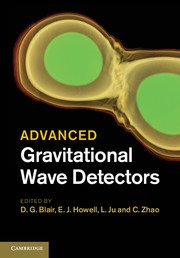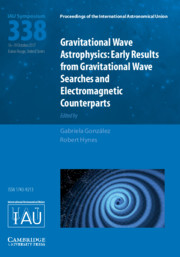The Detection of Gravitational Waves
Gravitational radiation has not been positively detected. Over the past two decades an army of extremely sensitive detectors has been built up, so that today its detection appears inevitable. In the opening chapters of this 1991 book David Blair introduces the concepts of gravitational waves within the context of general relativity. The sources of gravitational radiation for which there is direct observational evidence and those of a more speculative nature are described. He then gives a general introduction to the methods of detection. In the subsequent chapters he has drawn together the leading scientists in the field to give a comprehensive practical and theoretical account of the physics and technology of gravitational wave detection. David Blair has extensive knowledge of the subject and has visited most of the gravitational radiation experiments over the world. He has compiled a book which will be of lasting value to specialists, both the postgraduates and researchers in the field.
Reviews & endorsements
"...provides an informative and useful presentation of many of the technical issues associated with the field, written for experts and in the language of the field." Rainer Weiss, Nature
"Together these chapters give a fairly complete description of the state of the art of constructing gravitational wave detectors of all varieties. There is much of value here, some of it difficult to find in print elsewhere....the volume addresses an unmet need." Peter R. Saulson, Science
"...if you run a gravitational-wave group, a good way to start off a new staff member or graduate student might be to hand her this book with instructions to come back in a month. A theorist wishing to gain a thorough understanding of the experimental issues in gravitational-wave detection could also profit from this volume. In addition, anyone interested in sensitive mechanical measurements or in optical interferometry would do well to consult this book...." Carlton M. Caves, Physics Today
"...not only provides a clear understanding of the present state of the art, for resonant bar antennas as well as for laser interferometers and space experiments, but it also gives the `textbook' foundations required for the newcomer to enter this field of research....useful to the researcher and the student alike." G. V. Pallottino, Space Science Reviews
Product details
April 2011Adobe eBook Reader
9780511874161
0 pages
0kg
150 b/w illus. 15 tables
This ISBN is for an eBook version which is distributed on our behalf by a third party.
Table of Contents
- Part I. An Introduction to Gravitational Waves and Methods for their Detection:
- 1. Gravitational waves in general relativity D. G. Blair
- 2. Sources of gravitational waves D. G. Blair
- 3. Gravitational wave detectors D. G. Blair
- Part II. Gravitational Wave Detectors:
- 4. Resonant-bar detectors D. G. Blair
- 5. Gravity wave dewars W. O. Hamilton
- 6. Internal friction in high Q materials J. Ferreirinko
- 7. Motion amplifiers and passive transducers J. P. Richard
- 8. Parametric transducers P. J. Veitch
- 9. Detection of continuous waves K. Tsubono
- 10. Data analysis and algorithms for gravitational wave-antennas G. V. Paalottino
- Part III. Laser Interferometer Antennas:
- 11. A Michelson interferometer using delay lines W. Winkler
- 12. Fabry-Perot cavity gravity-wave detectors R. W. P. Drever
- 13. The stabilisation of lasers for interferometric gravitational wave detectors J. Hough
- 14. Vibration isolation for the test masses in interferometric gravitational wave detectors N. A. Robertson
- 15. Advanced techniques A. Brillet
- 16. Data processing, analysis and storage for interferometric antennas B. F. Schutz
- 17. Gravitational wave detection at low and very low frequencies R. W. Hellings.






